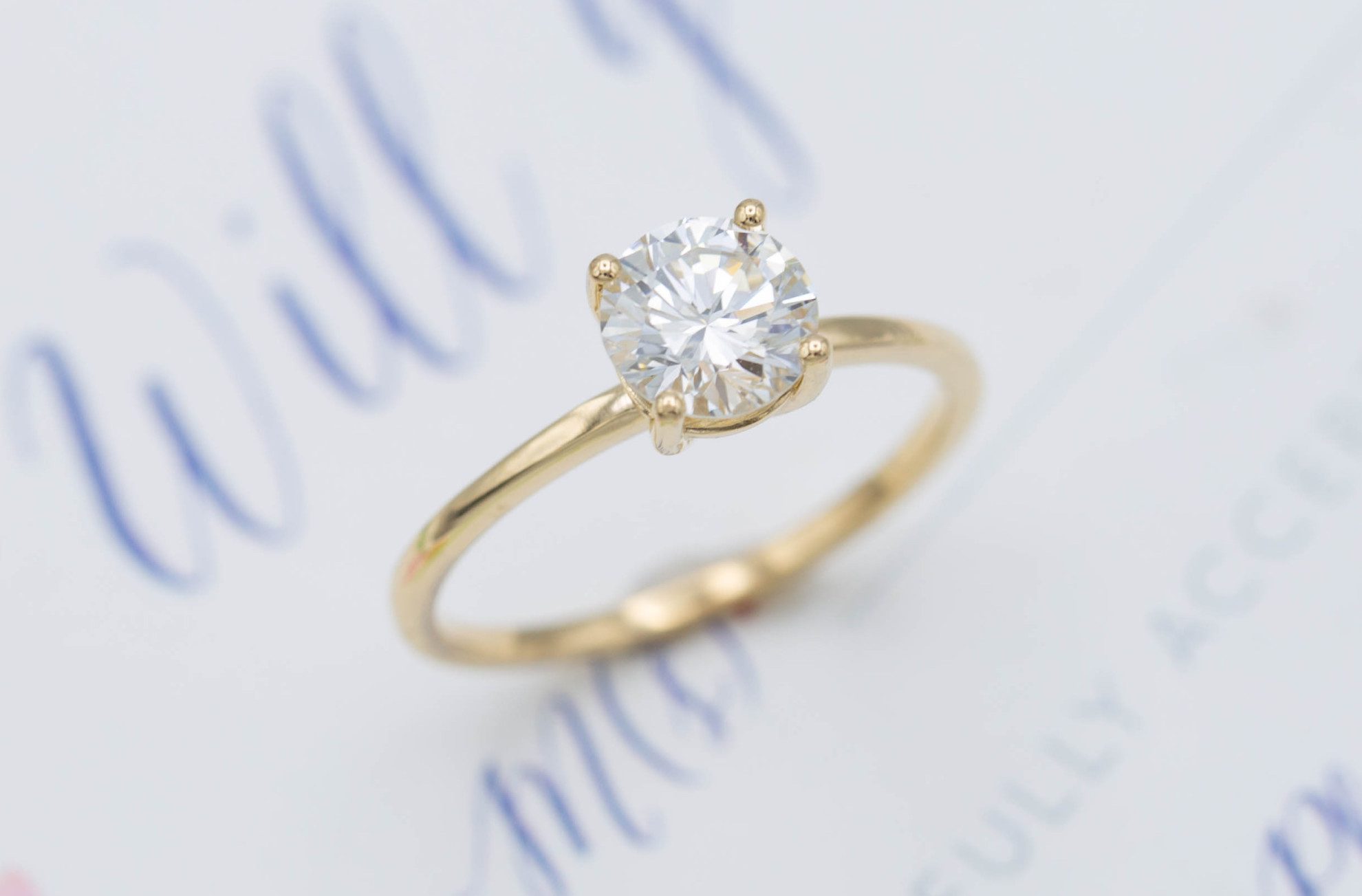How Wide Should My Engagement Ring Band Be?
4 Minute Read
So, you've chosen your diamond and you've chosen your ring metal. But have you considered how wide you want your engagement ring to be?
Just like diamond shape, size, and color and just like the type of metal, ring band width follows trends, varying from wide and bold to thin and dainty.
Aside from trends, the diamond (or other stone) and even the metal you choose for your ring will have a direct effect on the width of the band. So will your partner's hands as well as their own personal taste.
Here are some things to consider when choosing the band width for your engagement ring.
What's the Average Ring Band Width for Engagement Rings?
Ring width is measured in millimeters (mm), so ring width goes up and down in very small increments. The average engagement ring width falls between 2 and 6 mm, with 3 and 4 mm being pretty standard.
For reference a quarter is 1.75 mm thick, while a half dollar is 2.15 mm thick. Meanwhile, 6mm is almost ¼ inch thick.
Popular Engagement Ring Widths Compared
Engagement ring widths demonstrated by The Clear Cut
Diamond Size and Shape
The size and weight of your diamond will almost certainly dictate the width of your band. While thin, dainty bands are pretty trendy right now, something below 3mm will have a hard time supporting a stone bigger than a carat.
at James Allen
On the flip side, if you're going for a smaller stone, a wider band will make your diamond looks smaller, while a thinner band will make it look bigger.
at James Allen
If you're choosing a fancy shape, like a heart or emerald cut, a thinner band will put all the emphasis on the cut of your stone. But if you want side diamonds to frame your stone, opt for a band that's 3 or 4mm.
at James Allen
In fact, a band between 3 and 4mm will give you the most flexibility in terms of stone size and shape. It's not too small and not too big, so it can support a wide range of diamonds and styles.
Metal Choice
The type of metal you choose can have an effect on the width of your band, as well. Gold and silver, for instance, are softer metals. A thinner gold or silver band will wear more quickly and bend or break more easily.
If you are going for a thinner band, a strong metal like platinum or palladium would be a better choice.
Hand and Finger Size
If your partner has small hands or thin fingers, a wide band is going to look chunky and out of place. A thinner band, something around 2mm, will complement their fingers nicely.
If your partner has larger hands or thicker fingers, you can definitely play with thicker bands above 4mm. In fact, a smaller band may get lost on a bigger hand.
Your Partner's Lifestyle
If your partner has a very manual job, or has an active lifestyle, you're probably going to pick a stronger metal from the outset. But did you know you should pick a thicker band, too?
at James Allen
The more wear and tear on your partner's hands, the more likely the ring is going to suffer damage, including scratches, dents, and breaks. A thicker band will keep the ring from wearing away and protect the diamond better.
Your Partner's Personal Style
One of the most important considerations is your partner's own personal style.
Do they want a band with a lot of detailed scroll work or additional stones? A thicker band around 4mm or above can support some really beautiful details. Even a simple channel setting needs a band no thinner than 2mm.
Does your intended like to stack rings? A thinner band will allow that.
If your partner likes jewelry that makes a bold statement, you can certainly go larger than 6mm.
As you can see, there are a lot of factors to consider when choosing the thickness of your engagement ring band. Let's summarize.
What are the benefits of a thin engagement ring band?
A thinner band will make a smaller diamond look bigger. It will also put a fancy shape diamond or any solitaire front and center. It will complement a thin or small finger, as well.
at James Allen
Thin bands are trendy right now for their dainty look, so there are plenty out there to choose from.
What metal should I choose for a thin ring band ?
For a thinner band, one that is 2.5 mm or thinner, a strong metal like platinum or palladium is best.
What are the benefits of a thick engagement ring band?
A thick band is more durable, so it's appropriate for people who use their hands often. It can support a larger stone, as well as accent stones and other decorative work, as well.
Finally, a thicker band can make a bold statement on the wearer's finger.
If you're still unsure how thin or thick you want to go, shop around. Go to a jeweler and try on bands with different thicknesses. Or go online to get an up-close view of a variety of rings.
Laurie Mega
Related Articles
Vacation Proposal Guide
Best Diamond Color for Yellow Gold Rings
The Best Oval Diamond Engagement Rings for Every Budget
The 10 Best Places to Propose in the USA
Latest Articles
800 Years of Mogok: A Celebration in Tenuous Times
What is the Average Gemstone Faceting Yield?
Pyroxmangite Value, Price, and Jewelry Information
How to Identify Emerald Simulants and Synthetics
Never Stop Learning
When you join the IGS community, you get trusted diamond & gemstone information when you need it.
Get Gemology Insights
Get started with the International Gem Society’s free guide to gemstone identification. Join our weekly newsletter & get a free copy of the Gem ID Checklist!
